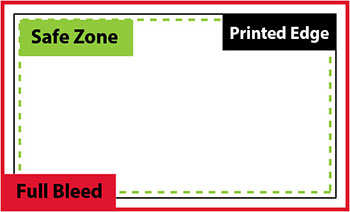File Preparation Guides
1. File Creation Guide
2. File Format Guide
3. Image Resolution
File Creation Guide
Resolution |
300dpi |
Safe Zone Height |
–Subtract .125″ From finished printed edge. |
Safe Zone Width |
–Subtract .125″ From finished printed edge. |
Bleed Width |
+Add .25″ From finished printed edge. |
Bleed Height |
+Add .25″ From finished printed edge. |
Color |
For optimal printing, we recommends uploading your files in CMYK. |
File Types |
You may upload a number of different file types: TIF, PDF, JPG, EPS, PNG and AI (Version 8 or lower). |
File Sizes |
Total size of all your files should not exceed 100 MB |

Safe Zone(green dashed line)
Text and other design elements must be placed within the safe zone. Placing them directly next to, or outside the safe zone will likely result in them being trimmed off in production.
Full Bleed(red border line)
To ensure that your background image covers the entire design space without leaving a white border, make sure that your design fully-extends to the full-bleed boundary.
File Format Guide
Print-ready files are accepted in the following formats only:
| File Extensions | Description/Program Used |
|
.ai, |
Adobe Illustrator drawing or vector graphics file |
|
.eps |
Encapsulated postscript image file created using Adobe Illustrator; designed for high resolution printing of illustrations; standard file format for importing and exporting PostScript files |
|
.tiff |
Tag Image File Format; preferred bitmap graphics format for high-resolution postscript printing |
|
.jpg or .jpeg |
standard format for photographic image compression developed by the Joint Photographic Experts Group |
|
.psd |
Bitmap file created using Adobe Photoshop |
|
|
Portable Document File from Adobe Acrobat |
Quick Facts about Bitmap Images
- Bitmap images are made up of colored dots (pixels) in a grid
- Also known as raster images
- Resolution dependent – resizing affects image quality
- Scanned images and digital photos are bitmaps
Quick Facts about Vector Images
- Vector Images are made up of individual objects composed of lines and shapes with different attributes such as color.
- Resolution Independent – scaling images does not affect quality
- Smaller file size
- Not suitable for photo-realistic reproduction
- Fonts are vector objects
Image Resolution
Resolution refers to the number of colored dots or pixels that make up an image. It is commonly expressed in dpi or dots per inch.
Resolution Rules-of-thumb:
- The higher the dpi, the greater the resolution, the better the image quality. But don’t go overboard. Higher resolution images create larger file size.
- Image resolution is directly and inversely proportional to an image’s physical size. When you increase the resolution of an image, reduce its size. When you enlarge an image, lower the resolution. Otherwise, the image will print poorly.
- For printed images, the ideal resolution is 300 dpi for images and 400 dpi for text at the final printed size.
Here is a chart to help you determine the proper dimensions of your image at your desired print size and in the recommended resolution of 300 dpi.
| PRINTED SIZE | MIN. IMAGE DIMENSIONS | IMAGE RESOLUTION |
|
2” x 1.60”
|
640 x 480 pixels
|
300 dpi
|
|
2″ x 2″
|
600 x 600 pixels
|
300 dpi
|
|
2.67” x 2”
|
800 x 600 pixels
|
300 dpi
|
|
2″ x 3″
|
400 x 600 pixels
|
300 dpi
|
|
3.41″ x 2.56″
|
1024 x 768 pixels
|
300 dpi
|
|
4.27″ x 3.20
|
1280 x 960 pixels
|
300 dpi
|
|
4” x 4”
|
1200 x 1200 pixels
|
300 dpi
|
|
4″ x 6″
|
800 x 600 pixels
|
300 dpi
|
|
5.33″ x 4.00″
|
1600 x 1200 pixels
|
300 dpi
|
|
5″ x 7″
|
1000 x 1400 pixels
|
300 dpi
|
|
8” x 5.33”
|
2400 x 1600 pixels
|
300 dpi
|
|
8″ x 10″
|
1600 x 2000 pixels
|
300 dpi
|
|
8.5” x 11”
|
2550 x 3300 pixels
|
300 dpi
|
More Helpful Tips:
- Your screen resolution doesn’t accurately reflect your image resolution because monitor displays usually have about 72 to 116 ppi. To view print resolution of your image, zoom in up to 300-400%.
- When taking pictures from a digital camera for your print project, it’s best to set your camera to the highest resolution setting.
- Four-Color Process Printing uses the CMYK color mode. Convert RGB images to CMYK using graphics editing software such as Adobe Photoshop.
- Save your images in a lossless file format such as .tif and .eps to maintain accuracy and quality.



